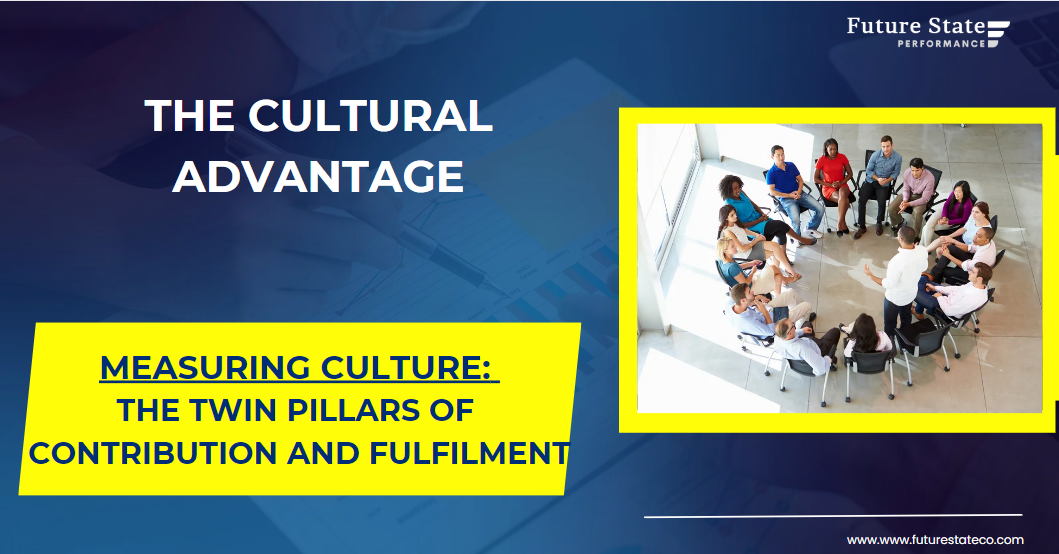Strategy
Measuring Culture: The Twin Pillars of Contribution and Fulfilment
By Shay Lynch
June 15, 2024
Summary
Creating a strong organisational culture requires measuring both employee contribution and fulfilment. Contribution metrics include productivity, innovation, collaboration, goal achievement, retention, and feedback participation. Fulfilment metrics focus on job satisfaction, work-life balance, engagement, career development opportunities, recognition, health and well-being, and psychological safety. By tracking these metrics, businesses can ensure they nurture a positive, productive work environment. This dual approach not only enhances performance but also boosts employee satisfaction and retention, promoting long-term success. Prioritising both aspects offers a holistic view of cultural strengths and areas for improvement, leading to a thriving, motivated workforce.
Introduction
For any business to thrive, cultivating a strong, positive culture is paramount. But how do we quantify something as inherently intangible as organisational culture? The key lies in understanding and measuring two fundamental aspects:
Contribution and
Fulfilment
These elements provide a comprehensive view of how employees interact with their work and their workplace, offering valuable insights into both productivity and satisfaction.
Contribution: Measuring the Impact
Employee Productivity
One of the most direct ways to measure contribution is through employee productivity. By tracking task completion rates, output per employee, and project turnaround times, businesses can gauge how effectively their employees are working. High productivity levels often indicate a motivated workforce that feels a sense of ownership over their tasks.
Metric Examples:
- Task completion rates
- Output per employee
- Project turnaround times
- Number of projects completed on time
Innovation and Initiative
Innovation is a crucial driver of business growth and a strong indicator of a healthy culture. Measuring innovation can reveal the extent to which employees feel empowered to contribute creatively. A culture that encourages innovation typically enjoys higher levels of engagement and satisfaction.
Metric Examples:
- Number of new ideas submitted
- Projects initiated by employees
- Improvement suggestions implemented
- Patent applications filed
Collaboration and Teamwork
Collaboration is the bedrock of any successful organisation. Measuring the frequency of cross-departmental projects, team project success rates, and collaborative tool usage can provide insights into how well employees work together. Effective collaboration not only enhances productivity but also nurtures a sense of community and shared purpose.
Metric Examples:
- Frequency of cross-departmental projects
- Team project success rates
- Usage of collaborative tools (e.g., Slack, Microsoft Teams)
- Employee survey responses on teamwork
Goal Achievement
Setting and achieving goals is fundamental to any business strategy. Measuring goals achieved can highlight how aligned employees are with the company’s objectives. Consistent goal achievement often correlates with high levels of motivation and clarity in role expectations.
Metric Examples:
- Percentage of individual goals met
- Percentage of team goals met
- Milestones reached within deadlines
- Alignment of goals with company objectives
Employee Retention
High turnover rates can be a red flag indicating issues within the company culture. Measuring retention rates can shed light on how well the company retains its talent. Low turnover rates usually suggest a positive work environment where employees feel valued and engaged.
Metric Examples:
- Employee turnover rates
- Average length of service
- Internal promotion rates
- Exit interview feedback
Feedback and Participation
A culture that values feedback and participation is likely to be more dynamic and resilient. These measurements can indicate how involved employees feel in the decision-making process. Active participation is a sign of a healthy, inclusive culture.
Metric Examples:
- Participation rates in feedback surveys
- Engagement levels in meetings
- Number of brainstorming sessions held
- Response rates to organisational communications
Fulfilment: Measuring Satisfaction and Well-being
Job Satisfaction
Employee satisfaction surveys are a staple in measuring fulfilment. By assessing satisfaction scores on various job aspects (e.g., role clarity, work-life balance), companies can gain insights into what drives employee happiness. High job satisfaction is often linked to lower turnover rates and higher productivity.
Metric Examples:
- Employee satisfaction scores
- Role clarity ratings
- Work-life balance ratings
- Overall job satisfaction index
Work-Life Balance
Balance can sometime be hard to find as work and customer pressures mount. However it’s a key area to work towards. Maintaining a healthy work-life balance is crucial for employee well-being. By taking a view on work life balance, it can help measure how well the company supports its employees in balancing their personal and professional lives. A good work-life balance often leads to higher job satisfaction and lower stress levels.
Metric Examples:
- Work-life balance survey responses
- Overtime hours worked
- Utilisation rates of flexible working arrangements
- Employee stress levels
Engagement Levels
Engagement surveys and pulse surveys provide real-time insights into how connected employees feel to their work and the organisation. High engagement levels typically indicate a workforce that is passionate, motivated, and committed to the company’s success.
Metric Examples:
- Employee engagement survey scores
- Pulse survey responses
- Participation in company events and activities
- Voluntary participation in additional projects
Career Development Opportunities
Providing ample career development opportunities is key to employee fulfilment. Continually assessing this area can reveal how well the company supports its employees’ growth. Employees who see clear paths for advancement are more likely to stay and invest in their roles.
Metric Examples:
- Number of training and development programs offered
- Internal mobility rates
- Career progression satisfaction scores
- Participation rates in development programs
Recognition and Reward
Recognition and reward systems play a significant role in employee fulfilment. This can highlight how well the company appreciates its employees. Fair and consistent recognition practices foster a positive, motivating work environment.
Metric Examples:
- Frequency of employee recognition events
- Employee satisfaction with recognition and reward systems
- Number of awards or acknowledgments given
- Perceived fairness of reward distribution
Health and Well-being
Employee well-being is a critical component of fulfilment. This is an underutilised are to measure and rates here can provide insights into the overall health of the workforce. Companies that prioritise health and well-being tend to have happier, more productive employees.
Metric Examples:
- Employee stress level assessments
- Participation rates in wellness programs
- Absenteeism rates
- Employee health survey responses
Psychological Safety
Creating an environment where employees feel safe to voice their ideas and concerns is essential for a thriving culture. Measure psychological safety and how conflicts are handled can indicate the level of safety within the organisation. High psychological safety is associated with greater innovation and collaboration.
Metric Examples:
- Psychological safety survey scores
- Incidence of reported conflicts
- Conflict resolution effectiveness
- Employee feedback on communication openness
In Conclusion
In conclusion, measuring culture through the lenses of contribution and fulfilment offers a holistic view of the organisational environment. By tracking key metrics such as productivity, innovation, collaboration, job satisfaction, and well-being, businesses can gain valuable insights into their cultural strengths and areas for improvement. This dual approach ensures that companies not only drive high performance but also foster a supportive and engaging work environment that promotes long-term employee satisfaction and retention.
______________________________
⏩What are your thoughts? 💬 – How are you measuring and improving your culture and contribution?🌟💼
🔔 Hit the notification icon to get notified on new content
🔁 If this resonates, feel free to repost
______________________________
#futurestateacademy #systemsthinking #CompanyCulture #EmployeeEngagement #OrganisationalDevelopment #Leadership #WorkplaceWellbeing #EmployeeSatisfaction #Innovation #Collaboration #CareerDevelopment #WorkLifeBalance



